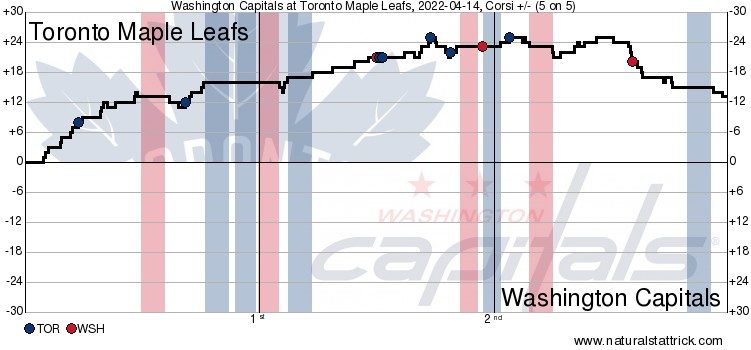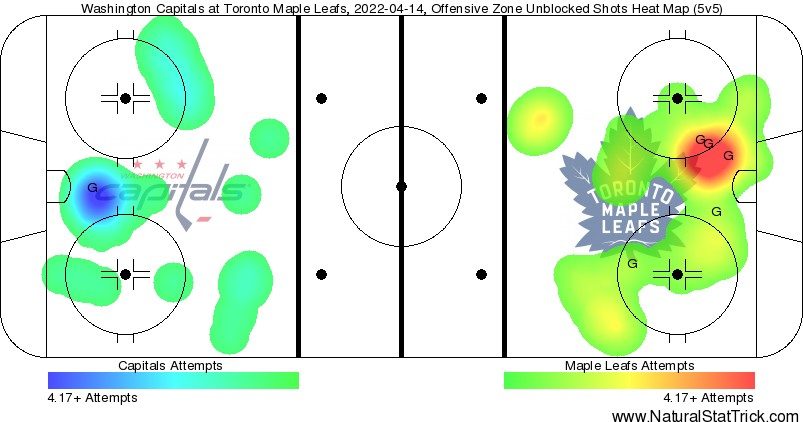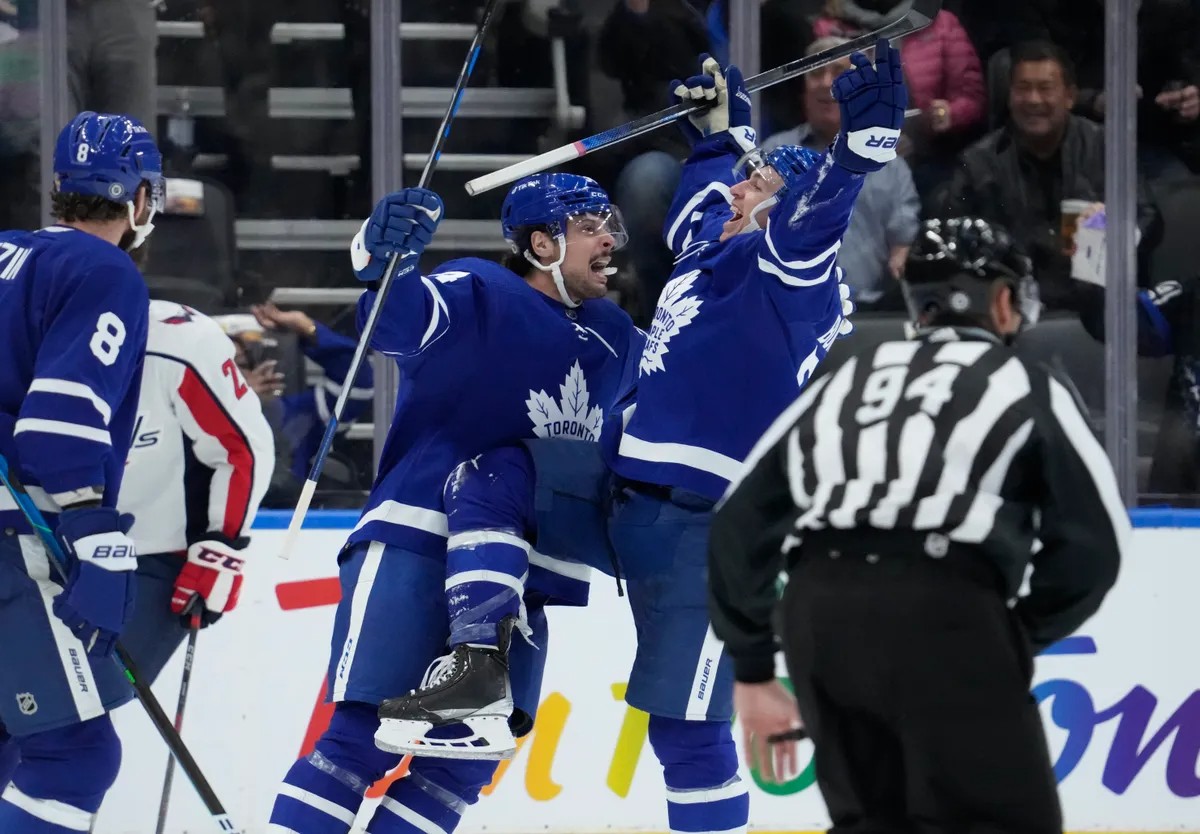The Toronto Maple Leafs responded to Tuesday’s poor outing against Buffalo with a resounding win over the Washington Capitals by a score of 7-3 at Scotiabank Arena.
While it was not the tandem of Auston Matthews and Mitch Marner carrying the Leafs for a change, there was still plenty of offense. William Nylander and Ilya Mikheyev each scored twice, John Tavares tallied three assists, and eight different Leafs garnered two points. There were also plenty of hits, a fight, and dazzling penalty killing from Toronto.
Your game in 10:
1. If you were looking for a performance to indicate that the Leafs were angry about what happened against Buffalo on Tuesday, the first 10 minutes of this game were a clear sign of that. At the midway point of the opening period, shots were 5-0 in favor of Toronto and that almost understates how dominant of an effort it was.
After being held off the scoresheet against the Sabres, Toronto’s top line showed up in full force early in this one. Auston Matthews helped dig it off the wall, Mitch Marner grabbed the puck, and Marner made a dagger pass to Michael Bunting, who snapped the goal-less drought:
Bunting ends a 17-game goal-less drought. 1-0 Leafs #LeafsForever pic.twitter.com/Ml0TSPCW1Q
— Maple Leafs Hotstove (@LeafsNews) April 14, 2022
I didn’t think this was a particularly great game from the top line outside of that, and they were the second-worst performing line in the advanced numbers for Toronto tonight (above only the fourth line), but this was a big goal to set the tone. The Leafs came out angry and once the Bunting goal went in, it was on.
The starts of games have been of some concern in the Maple Leafs media-verse during the course of the season, but it’s hard to start a game any better than the Leafs did tonight.
2. There’s been some discussion about William Nylander‘s new role on the third line as well, and tonight he showed how he can make that line with Pierre Engvall and David Kämpf work: by dominating a game.
The Swedish winger took over in his minutes tonight, whether he was driving his own line or (occasionally) jumping up to skate with the top two lines. He was flying around the ice with wild abandon, making high-danger pass after high-danger pass and taking some of those chances for his own. He had a couple of chances early (including one incredible Samsonov save) and then converted on one:
Nylander blasts one home for redemption. 2-0 Leafs #LeafsForever pic.twitter.com/LiGJBMEHi4
— Maple Leafs Hotstove (@LeafsNews) April 14, 2022
Scoring chances were 6-1 in Toronto’s favor with Nylander on the ice at 5v5 in this game and high-danger chances were 3-0, per Natural Stat Trick. He was one of the top forwards for the Leafs in expected goals percentage at even strength. When Nylander plays that sort of hockey, he can make just about any line combination work.
I agree with Anthony Petrielli that the Leafs should tinker a little bit and experiment with Colin Blackwell at center on that line instead of Kämpf. I’m not sure how much Kämpf helps Nylander, but when Nylander plays like this, it doesn’t matter. An angry, motivated Nylander who is controlling the game is the key to making the “stars on three different lines” experiment work.
3. The Maple Leafs continued to dictate play well into the second period, but good goaltending from Ilya Samsonov managed to keep the game within two goals. And then, all of the sudden, it was a one-goal game.
At 4v4, John Carlson took an outside lane, burned past Jake Muzzin to break in all alone on Jack Campbell, and finished the opportunity:
Great move by Carlson. 2-1 #LeafsForever pic.twitter.com/9kmaTZ0Y2J
— Maple Leafs Hotstove (@LeafsNews) April 15, 2022
I continue to be somewhat puzzled by Sheldon Keefe’s decision to play Muzzin as much as he has at 4v4 and 3v3. The speed-focused style of play at those strengths simply does not suit what Jake Muzzin is at this point in his career.
Muzzin has looked pretty solid to me since returning from his second concussion, save for when he is placed out in those difficult situations. He registered a 73.71% xGF% at 5v5 tonight. The other numbers were fine for him at that strength, but the kicker is that the numbers decline considerably when you move from 5v5 to even strength, which includes 4v4. His xGF% at EV was 42.78%, a massive gulf compared to 5v5. In other words, I don’t have qualms about Muzzin at 5v5 right now, but I absolutely do at 4v4 and 3v3, and the numbers reflect that.
Somewhat related, but I thought his defense-mate, TJ Brodie, was very good tonight. There were two separate excellent defensive plays from Brodie — one to cut off a pass that was going to be a sure-goal, and another to block on the PK in the third period.
I think that the defensive pairings we saw tonight might be the best configuration that the Leafs can offer for the playoffs, and part of that is that Brodie’s defensive ability allows Muzzin to take more chances offensively. Muzzin has been an underrated offensive defenseman for some time. Even pre-injury, while his defensive impacts declined hard, his offensive ones were still solid.
The pairing of Muzzin and Justin Holl didn’t work this season because Holl can’t drive a pair defensively on his own if Muzzin isn’t a defensive monster, but Brodie can. I’d like to see more of Muzzin and Brodie together.
4. The above Capitals goal brought that sinking feeling that accompanies a goal by a team that’s been on their heels and suddenly makes a lopsided game feel not so lopsided anymore. The feeling didn’t last very long, though; the Leafs quickly scored right back with one of two tallies at 4v4 during the same stint that Carlson scored in what was a helter skelter two minutes of hockey.
The first goal came off a great rush from Morgan Rielly, who created a juicy rebound that Ilya Lyubushkin jackhammered in from the point:
Lyubushkin responds 11 seconds later with his first as a Leaf. 3-1 Leafs #LeafsForever pic.twitter.com/cigejKKXVL
— Maple Leafs Hotstove (@LeafsNews) April 15, 2022
That was the first goal for Lyubushkin as a Maple Leaf and just his second in 203 career NHL games. Rielly picked up two more assists tonight and continues to add to his career high in that metric. He also now has 65 points; meaning, seven points in the final eight games would equal his career high set back in 2018-19.
Moments after that goal, it was Nylander’s turn to dazzle with the open ice. He took a pass from Rielly, sped into the offensive zone, and made a great pass to Rielly, who was robbed by Samsonov. Nylander then collected the loose puck after a scrum that involved John Tavares for his second of the night:
Nylander taps home his second of the game. 4-1 Leafs #LeafsForever pic.twitter.com/GHcNzy9VMn
— Maple Leafs Hotstove (@LeafsNews) April 15, 2022
The speed of the Maple Leafs up front (+ Rielly) allows them to be well suited for 4v4, and we saw that tonight.
A couple notes on Nylander’s season: With two goals, he has now hit 30 for the second time in his career. Two more will give him a new career high, while he is still tied for a career high in assists (41). Nylander still has an outside shot at 80 points, but it’s been a career year in every offensive category for the 25-year-old.
5. After another dominant showing, it’s time to wonder if the Leafs have something in the second line of John Tavares, Alex Kerfoot, and Ilya Mikheyev. Entering tonight, that was the best line Tavares has been a part of that has logged at least 50 minutes at 5v5 this season (by xGF%), and the second best among the nine combos that have logged at least 30 minutes. More importantly, this combination doesn’t require breaking up the top line (the only line better was Bunting-Tavares-Marner).
Tonight, the second line was sharp from the get-go (my first game note was about an excellent shift from the Tavares line). The speed and forechecking ability of Kerfoot and Mikheyev complement Tavares well, and the ice was dramatically tilted in Toronto’s favor when those three were out there together.
The Leafs owned >80% of the expected goals, scoring chances, and high-danger chances when Tavares and Kerfoot were on the ice at 5v5, and it was Mikheyev who did the scoring for the line. An impressive shift in the second period saw the Leafs work the Caps off the cycle with Tavares and Mikheyev out there (this time with Auston Matthews) before Mikheyev cashed in the loose puck:
Mikheyev deflects in the puck. 5-1 Leafs #LeafsForever pic.twitter.com/B3chZXUkVh
— Maple Leafs Hotstove (@LeafsNews) April 15, 2022
By this point, the game was essentially over, but they weren’t done scoring. Ilya Mikheyev would put another one in the back of the net off a feed from Lyubushkin leading the rush, using his speed and newfangled backhand to slide it past Vitek Vanecek, who had been inserted in relief for Washington:
What a move by Mikheyev. 7-2 Leafs #LeafsForever pic.twitter.com/O8QycOXmRP
— Maple Leafs Hotstove (@LeafsNews) April 15, 2022
This version of Mikheyev is going to earn the Russian a lot of money in the summer, and it has also made Tavares look better. The captain quietly collected three assists tonight and has now hit the 70-point plateau for the sixth time in his career.
6. The physicality of this game was a real storyline, even if it doesn’t show up in any major way on the stat sheet. It was already a little rough and tumble before Tom Wilson bowled into Jack Campbell, yanking the mask off the Toronto netminder:
Scary collision as Wilson hits Campbell #LeafsForever pic.twitter.com/xfcgowSAV3
— Maple Leafs Hotstove (@LeafsNews) April 14, 2022
Wilson went to the box for that, and you knew that payback would be coming. It did in the form of Kyle Clifford, who fought Wilson valiantly, although the Washington forward got the better of that matchup.
The fourth line of Clifford, Wayne Simmonds, and Colin Blackwell didn’t do much of anything again tonight (all <20% xGF% at 5v5), but they were still valuable to have in the lineup because of the physical edge they added. The rest of the Toronto lineup continues to play physically as well as was shown in Morgan Rielly‘s thundering hit on Johan Larsson:
Rielly with a booming hit #LeafsForever pic.twitter.com/SkWF32dMap
— Maple Leafs Hotstove (@LeafsNews) April 15, 2022
It feels like the Leafs have played a heavier, more physical game ever since Lyubushkin was acquired since Arizona, as if the Russian Bear infected the locker room with a newfound edge. Tonight was a scrappy game despite the scoring, and that physical component was important.
7. A consequence of the physical manner of play was a good number of penalties being doled out, which provided a chance for Toronto to get its slumping power play going. It didn’t happen.
The Leafs had another ofer night with the man advantage, but I didn’t think it was because of a shortage of looks. Unlike Tuesday, when I described the power play as “purposeless,” Toronto created a decent number of chances tonight. Bunting had a one-time blast from the slot on the first power play opportunity, and I thought Mark Giordano looked good playing the point on the third power-play chance.
There were several truncated PPs, so the Leafs didn’t get a ton of cohesive power plays as normal, but they did decently with the time the team got. It feels like the team is close to busting out and ending the drought after tonight, as it has now been a week since the last PPG (the Matthews 55th goal against Dallas). The process looked fine, and perhaps one will go in on Saturday night against Ottawa.
8. On the flip side, the Leafs also found themselves killing penalties a decent amount, too. I highlighted the penalty kill’s disappointing performance against Buffalo on Tuesday, so it’s time to give them their proper due after a perfect night tonight. Washington was 0/4 on the power play tonight; they had little rhythm, settling for blasts from the perimeter that rarely came close to hitting Jack Campbell. Meanwhile, the Leafs’ speed and swarming tenacity helped create more chances the other way.
Indeed, per Natural Stat Trick’s numbers, two high-danger chances were created during the 7:09 that Washington was on the PP tonight… and both were in favor of Toronto. I don’t know exactly which moments registered as those high-danger chances, but the Leafs got several looks while shorthanded, including one on the rush from Pierre Engvall early on, and then two breakaways from Alex Kerfoot and Ilya Mikheyev in the third period.
Here was that Kerfoot look:
Kerfoot nearly got a SH tally #LeafsForever pic.twitter.com/AMNMKY6kDK
— Maple Leafs Hotstove (@LeafsNews) April 15, 2022
The speed and aggressiveness of Toronto’s PK have made it the NHL’s best at generating offensive chances shorthanded. We’re getting to the point where it must be near the top of the scouting report for opposing teams looking at the Leafs.
9. That previous point was my first mention of Pierre Engvall, but he deserves more of a proper shoutout for his effort tonight. The Leafs were the better team with him on the ice at 5v5, and his penalty-killing ability flashed in style. Thankfully, he had a central role in a goal, getting rewarded for his efforts.
A puck dribbled out past the blue line marking the Toronto defensive zone and the giraffe was off to the races:
Bunting goes bar-down for his second. 6-1 Leafs #LeafsForever pic.twitter.com/HCuIOztHDQ
— Maple Leafs Hotstove (@LeafsNews) April 15, 2022
That was a perfect pass from Engvall, who shielded the puck well from Martin Fehervary, waiting until the angle was just right to dish that saucer feed across to the waiting Bunting, who got his second goal of the night.
Engvall collected two assists tonight, which gives him 30 points for the first time in his NHL career. After coming close to ending up on waivers at different points (including early this season), the Swede has grown into an extremely valuable piece of Toronto’s top nine.
10. To finish this off, let’s talk about Jack Campbell. The Leafs’ goalie hadn’t played in a week and it was a decent performance. Not great, but not terrible.
Campbell made a couple of big saves (including a pad-stack one in the third period) and stopped 22 of 25 shots, but I think ideally you would’ve liked him to come up with one of the three goals that went in. That’s what the numbers indicated, hitting him with -0.62 goals saved above expected in Evolving Hockey’s data.
Early on in the game, it was a Chris Osgood-esque performance, where the goalie isn’t asked to do much of anything while the team in front of him blasts the opponent to smithereens. After Toronto got a huge lead, the defense predictably loosened up a bit and Campbell faced a few more chances.
The first goal was poor gap control from Muzzin, but a more locked-in Campbell may have been able to stop it. That was probably not the one you’d most want back, though. For my money, it was the third one:
Dowd taps it home. 7-3 #LeafsForever pic.twitter.com/PwH7kgQUEc
— Maple Leafs Hotstove (@LeafsNews) April 15, 2022
That’s not particularly great defense from Timothy Liljegren, who abandoned his man in front to go for the shot block and then did not come up with it. That causes the goal when the rebound happens, but I think you’d prefer Campbell to not quick that rebound out so far, considering it was an unscreened shot.
The second goal allowed was also not great defense in allowing the pass across. It was a considerably more difficult chance against, but Campbell is way out of position and looks very awkward sliding laterally:
Wilson blasts one home. 6-2 #LeafsForever pic.twitter.com/G5GExckdiM
— Maple Leafs Hotstove (@LeafsNews) April 15, 2022
I think the best way to describe tonight’s three goals against is that none of them were in pure “should’ve had it” territory, but Campbell had a shot at all three. In a perfect world, you’d like him to stop at least one of them, but it’s not a travesty that he didn’t, and it’s a bit more understandable when you remember the week-long layoff.
Sheldon Keefe is in a bit of an odd situation with Campbell going into these last eight games. You need to play him a bit more than once-a-week to get him in a rhythm that will simulate the flow of a seven-game series where games are essentially every other night, but you also have to be very careful about over-use — especially when we were told just a few days ago that Campbell is not yet 100%.
With eight games left to go, I think it makes the most sense to go 50-50 with Campbell and Erik Källgren. There are two back-to-backs, so give each guy one of those two and then split the other four games, perhaps with Campbell getting Tampa and Boston and Källgren getting Philly and Detroit.
Game Flow: 5v5 Shot Attempts

Heat Map: 5v5 Shot Attempts































![New Leaf Anthony Stolarz on the opportunity in Toronto: “In Florida, I knew my role as a backup… Now, [Joseph Woll] and I are competing for starts… As a goalie, that’s all you can ask for” Anthony Stolarz, Stanley Cup win, now Maple Leaf](https://mapleleafshotstove.com/wp-content/uploads/2024/07/anthony-stolarz-sc-100x70.jpg)
